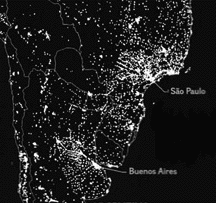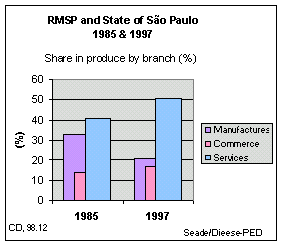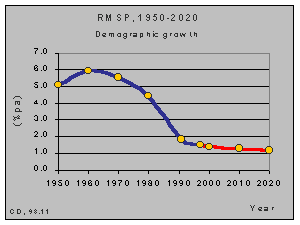Previous
If São Paulo is the biggest of South American metropolises, it is also the youngest. Thus Rio de Janeiro became capital of the Portuguese colony back in 1763 due to its increased importance stemming from its proximity to the mining region of Minas Gerais where gold extraction was at its heydays, whereas the Province of Buenos Aires (roughly modern Argentina plus Paraguay and Bolivia) was promoted to Vice-Kingdom of the River Plate almost at the same time (1776), according to the growing influence of Buenos Ayres at the expense of Lima. In contrast, as late as 1850 São Paulo was just a small borough of hardly 15.000 people. Indeed, it had been little more than a jumping board for the bandeiras, expeditions of slave hunting or outright conquest in the Portugal's struggle with Spain for the South-Western border regions, for several centuries up to that date.
But 1850 was
the year of the suspension in Brazil of the slave trade from Africa and
also of the promulgation of the Land Laws, which instituted private
property in land. In practical terms this set the conditions for
the introduction of wage labour: or in other terms, of capitalism, in Brazil,
about three decades after the Declaration of Independence (1822). With
wage labour and capitalism came their companion processes of industrialization
and urbanization, and a long period of high rates of accumulation and rapid
growth, similar to the one experienced in England in the eighteenth century
(2![]() ).
And São Paulo was to become the centre of this process. A peculiarity
of the formation of Brazilian society – and which could not but leave its
mark on São Paulo as well – is that although wage labour predominates,
it is not a bourgeois society: on Independence, there was no revolution
and demise of the colonial elite with its substitution by a capitalist
class (the bourgeoisie). On the contrary, Independence was merely a process
by which the colonial elite set up a State apparatus of its own, in face
of the impossibility of a weakened Portugal to keep providing that institutional
and military framework. With the elite society, its economic base, namely,
colonial production – in which part of the surplus produced by society
is handed over to the metropole – also remained in place and became, with
Indepence, a process of hindered accumulation – accumulation, but
with expatriation of a portion of the national surplus produce, whether
in the form of interest payment, profit remittance, unfavourable terms
of trade or freight and insurance payments.(3
).
And São Paulo was to become the centre of this process. A peculiarity
of the formation of Brazilian society – and which could not but leave its
mark on São Paulo as well – is that although wage labour predominates,
it is not a bourgeois society: on Independence, there was no revolution
and demise of the colonial elite with its substitution by a capitalist
class (the bourgeoisie). On the contrary, Independence was merely a process
by which the colonial elite set up a State apparatus of its own, in face
of the impossibility of a weakened Portugal to keep providing that institutional
and military framework. With the elite society, its economic base, namely,
colonial production – in which part of the surplus produced by society
is handed over to the metropole – also remained in place and became, with
Indepence, a process of hindered accumulation – accumulation, but
with expatriation of a portion of the national surplus produce, whether
in the form of interest payment, profit remittance, unfavourable terms
of trade or freight and insurance payments.(3![]() )
)
 |
Figure 1: Urbanization at the core of Mercosul- A night view of southern Brazil, Paraguay, Uruguai and northern Argentina and Chile shows the intensity of urbanization in the region (from the supplement of the National Geographic, Oct.98) |
So São Paulo became the main economic centre of the Brazilian economy ever since coffee production, in its southward movement, happened to be centred in São Paulo precisely at the start of capitalist development in Brazil in the mid-nineteenth century. For more than half a century coffee was the main export staple of Brazil and São Paulo became the new gravity centre of Brazilian economy. Thus the twin processes of industrialization and urbanization starting at the same time became also centred there and São Paulo rapidly became the major industrial town of the country. When the world crisis of 1929 put an end to the ‘coffee cycle’, the leading position of São Paulo in the Brazilian economy had already been firmly established. The ensuing balance of trade constraint made it necessary to broaden industrial production in order to cater for the increasing home market, and the dynamism of São Paulo increased. Further, it became henceforth based on manufacturing rather than on an ephemeral export staple, and thus it kept its position as the main economic centre of the country to this day.
When the pace of economic growth began to slacken
by the end of the 1970-s, Brazil was already the seventh biggest national
product of the world with a manifold structure of manufactures of which
the branches of car production was the ‘locomotive industry’. It lost position
later (after two ‘lost decades’ resulting from recessive policies); today
it must be, depending on the exchange rates and calculation methods, among
the ten or eleven biggest economies. São Paulo kept its hegemony
and its position as the dynamic centre of this process and by 1970 its
share in manufactures amounted to over 42% of the national produce. Within
the State of São Paulo, in turn, the metropolitan region concentrates
the bulk of all branches of industry except agriculture (>> Figure 2).
Furthermore, in spite of an hypothetical and much-debated process of ‘decentralization’,
a loss in its share in manufactures – a declining portion of both national
and São Paulo State product – is more than offset by an increase
in São Paulo’s share in the São Paulo State’s product in
the tertiary: trade and services industry.
 |
Figure 2: RMSP and State of São Paulo, 1985 & 1997 If the metropolitan region has been losing some of its share in the State’s produce in manufactures, it also has been increasing its share in both commerce and services industry in the period 1985-97. |
In terms of urban growth, this meant about a century (1870-1970) of rapid growth, during which São Paulo grew from a small burg to become a major metropolis, from 23.000 to over 8 million people (see also >> Map 1). The last two decades were a period of twofold transition for the São Paulo Metropolitan Region: on the one hand, its galloping growth rate fell to almost vegetative level with a drastic fall in migration intake (>> Figure 3). It still grew of course – today it is an agglomeration of some 18 million people – but at growth rates gradually falling to near-vegetative level and forecasts are that it will not reach much over 23 million people by 2020.
